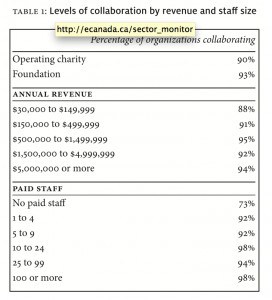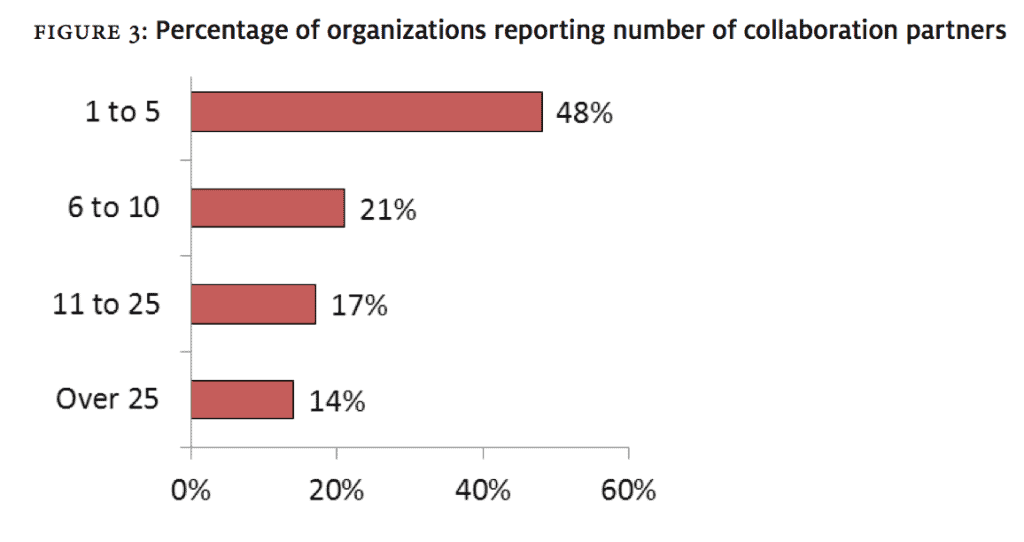Rumblings about transformative partnerships in the charitable and nonprofit sector are resonating across the country. These range from organizations more narrowly interested in collaboration as an immediate means of adapting to the current economic upheaval to others that see the current upswing in interest as part of a more general trend toward increased collaboration over the coming decade.
Given the widespread interest in the topic, Imagine Canada’s latest Sector Monitor included a battery of questions designed to explore the issue of collaboration.1 The aim of this exploration was to try to establish some basic benchmarks: how many organizations are collaborating, how common some key forms of collaboration are, and the current scale or intensity of collaboration as measured at the level of the individual organization. This article presents some of our initial findings.
How Common Is Collaboration?
Perhaps unsurprisingly, our results indicated that collaboration is ubiquitous. The vast majority (91%) of organizations surveyed reported that they engaged in some form of collaboration during the last 12 months.2
Generally speaking, the likelihood of collaborating does not appear to vary much with the particular characteristics of the organization. For example, operating charities and foundations were equally likely to collaborate (90% of operating charities and 93% of foundations; see Table 1)3. Similarly, while the likelihood of collaboration seems to increase with the level of revenue organizations receive, the trend is far from pronounced. An even less pronounced trend is seen with paid staff numbers.
Interestingly, these collaboration figures are strikingly higher than those seen in the first Sector Monitor, which covered the period from late 2008 until late 2009, when charitable leaders were asked whether they had collaborated with another organization in order to reduce expenses since the onset of the economic downturn. In that survey, less than half (40%) reported that they had done so (Lasby & Barr 2010). Clearly, although collaboration is seen as a means of adapting to economic pressures, it is also a regular and important part of how charities work, regardless of conditions.
How Common Are Different Forms Of Collaboration?
The most common forms of collaboration were sharing information and communications networks (79% of organizations reported collaborating in this way), co-ordination of programs or services (59%), and joint delivery of programs or services (57%). Other relatively common forms of collaboration included sharing facilities (46%), joint funding proposals (44%), and sharing capital equipment such as computers (33%; see Figure 1).
figure 1: Percentage of organizations engaging in various forms of collaboration
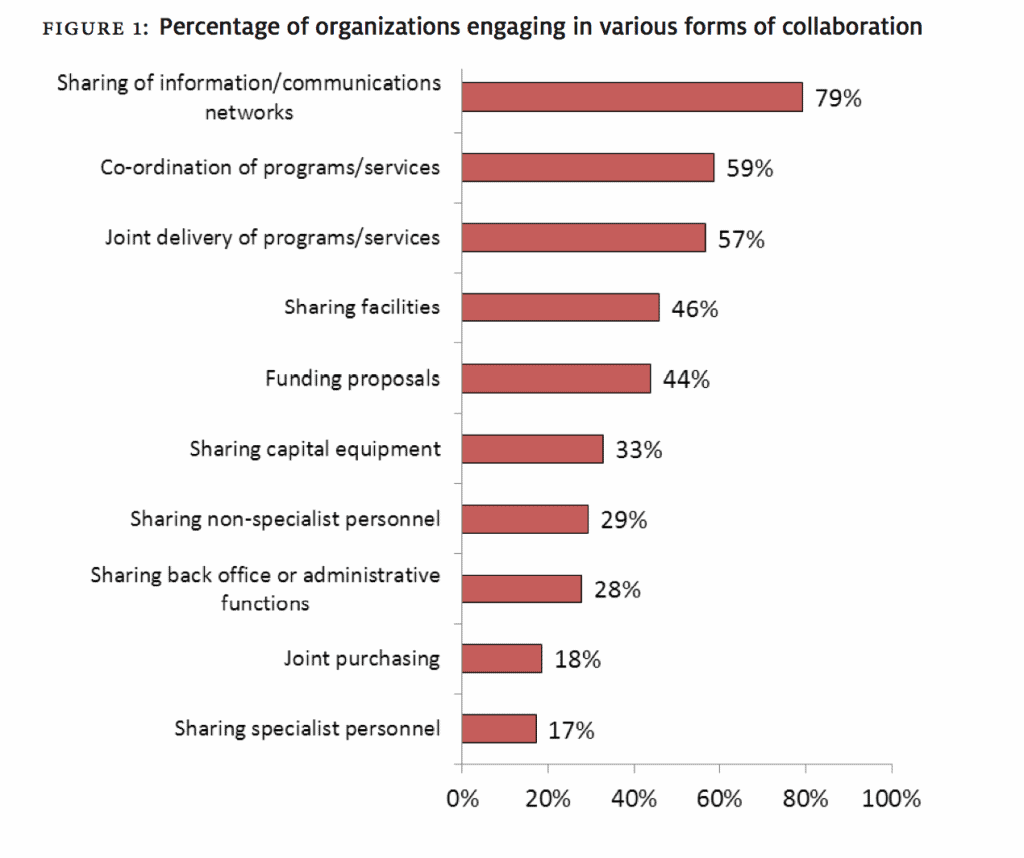 How Many Collaborations Do Organizations Participate In?
How Many Collaborations Do Organizations Participate In?
Respondents who reported collaborating stated that they engaged in an average of 13.9 collaborations over the previous year. Although foundations were as likely as operating charities to collaborate, they engaged in far fewer collaborations, on average, than operating charities (5.7 vs. 15.5 for operating charities). While the average number of collaborations is relatively high, it is skewed by a small number of organizations that engaged in many collaborations. Over half of organizations (56%) reported working on 1 to 5 collaboration projects, while one fifth worked on 6 to 10 (20%; see Figure 2).
figure 2: Percentage of organizations reporting number of collaboration projects
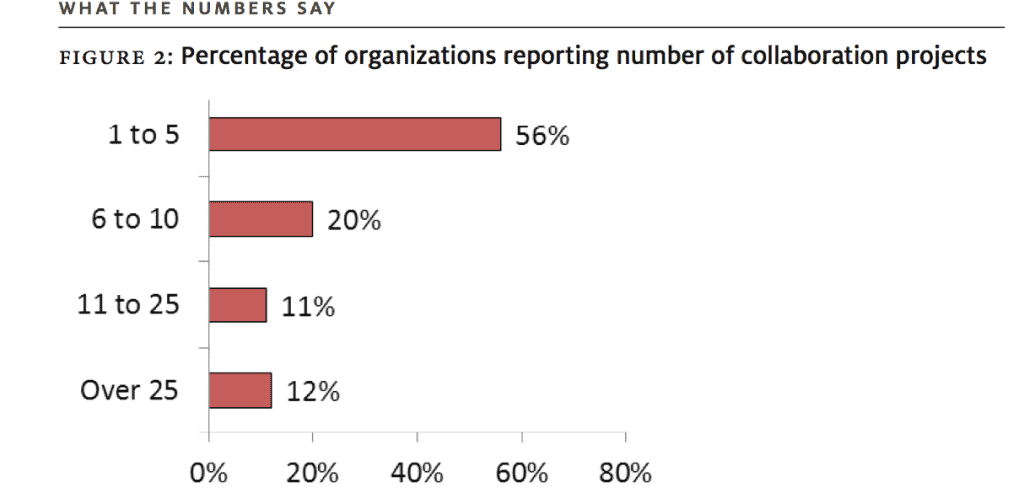 How Many Other Organizations Do Charities Collaborate With?
How Many Other Organizations Do Charities Collaborate With?
As for the number of other organizations charities collaborate with, most respondents (who indicated collaborating) reported working with an average of 13.8 other entities. As with the number of collaborations, operating charities reported a higher average and worked with more organizations than did foundations (14.3 vs. 11.4 for foundations). Again, these numbers are skewed by a small number of organizations that collaborate with many organizations. Almost half of organizations (48%) reported working with 1 to 5 other organizations, while a fifth worked with 6 to 10 (21%; see Figure 3).
figure 3: Percentage of organizations reporting number of collaboration partners
How Often Do Organizations Collaborate?
Respondents were also asked about how frequently their organization’s volunteers and paid staff work with the other organizations that they collaborate with. On average, 40% of collaborations involved organizations’ volunteers or paid staff working with their collaboration partners annually, while about one fifth of collaborations engaged them on a monthly (22%), weekly (17%) or daily (19%) basis (see Table 2). Overall, collaborations appear to involve operating charities as frequently as foundations.
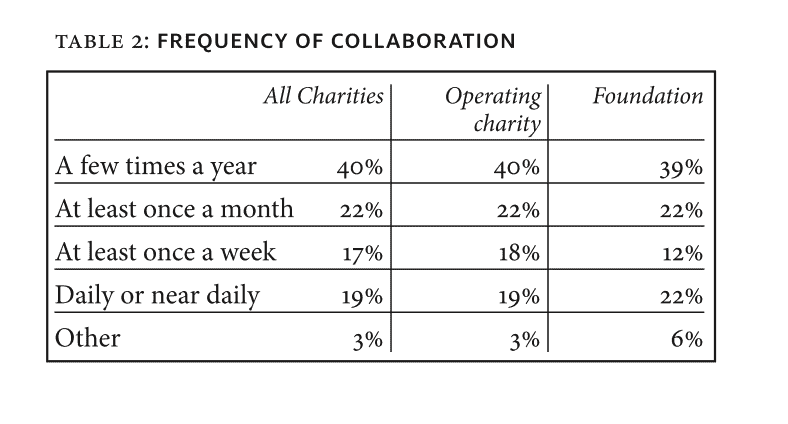 Conclusion
Conclusion
It is evident that collaboration permeates the sector. This is the case regardless of economic conditions. However, the scale of collaboration differs with the organization; most organizations collaborate on a relatively small scale, while a few collaborate to a larger degree. These results have helped to establish the initial benchmarks on collaboration for the Sector Monitor. Imagine Canada will continue to investigate these trends and provide timely insights into the condition of Canada’s charitable sector.
Notes
1. The Sector Monitor is the new Imagine Canada survey program designed to regularly take the pulse of Canada’s charitable and nonprofit sector: http://www.imaginecanada.ca/ sector_monitor. For the purpose of the latest Sector Monitor, collaboration was defined as working with another organization (nonprofit, charity, business, government, etc.) to carry out an organization’s mission (not including traditional funder-fundee relationships).
2. The survey was sent to the leaders of 3,923 registered charities with annual revenues of $30,000 or more that were not religious congregations. We received responses from 1,523 of these leaders, for a total response rate of 39%. We limited the survey to registered charities to allow for direct comparison with information available from the Canada Revenue Agency. Collaboration was measured by asking respondents whether their organization engaged in any of ten specific types of activity with another organization to carry out their mission.
3. The term operating charity refers to registered charities that are neither public nor private foundations. The overwhelming majority (88%) of the approximately 85,000 registered charities in Canada are operating charities.
Lindsey Vodarek is a research associate and David Lasby is a senior research associate at Imagine Canada.
